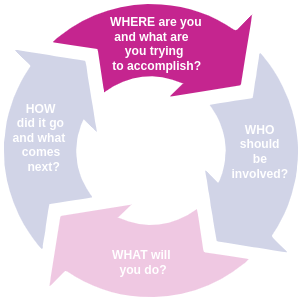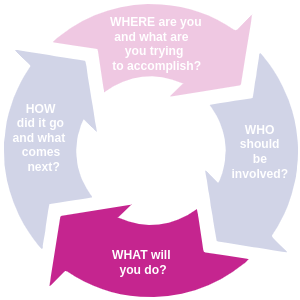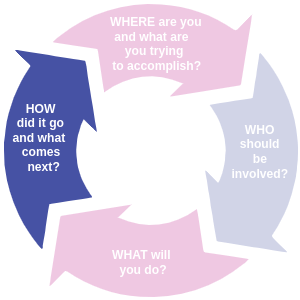Cycle of Reflection and Action
To be intentional about change, a department must have a clear understanding of its present situation and a vision for what it would like to become. We’ve provided a cycle of self-reflection questions to help departments start conversations and structure their thinking about how to get from where they are to where they want to be.
To be clear, nobody undertakes a change process by following a predetermined set of steps. Real-life change processes are messy and non-linear. Nevertheless, successful change processes leading to sustainable departmental transformation inevitably involve all of these steps in one form and at one time or another. So even though we’re presenting what looks like a linear cyclic process, it’s really intended as a tool to use to make sure your team is asking the right questions, not ignoring important considerations or leaving out important steps. These steps are a way of externalizing the elements of a process that, one aspires, will eventually become internalized and implicit in all of your department’s efforts to undertake change.
Where Are You and What Are You Trying to Accomplish?
A key element of designing change is making sense of your department’s landscape.

Here are some questions your team should ask to do this:
- What problem are you trying to solve?
- How do you know if that’s really the problem?
- What information do you need to gain a clear picture of your current situation?
- What is your ultimate goal or vision?
- How do your objectives fit with the mission and priorities of your department and/or institution?
Here are some additional factors to consider:
Change efforts should be rooted in a clear understanding of the departmental mission, priorities, and context.
- If your department has not clearly articulated a mission and vision for itself, consider conducting a conversation among all departmental stakeholders to develop one before embarking on a significant change effort to ensure those efforts are consistent with a shared vision of the long-term future of the department.
- If your department does not have a current strategic plan, consider developing one so that significant initiatives are embedded in a well thought-out plan that properly accounts for departmental priorities, opportunities, and constraints and is adequately grounded in data about current conditions.
- Plans for significant change should consider the balance between the potential gains and commitment of resources, and in particular what other priorities may have to be deferred.
Sometimes the most productive approach to a challenge facing your department may not be the superficially obvious solution. For example, enrollment problems may have more to do with issues with the climate for students in the department than with the lack of compelling programs.
- Before beginning a significant change effort ensure that your department has sufficient data about the nature of its challenges gathered from a wide range of stakeholders and sources to be confident about the reasons for your current situation. These data may also provide clues to likely pathways to sustainable solutions. Proposed solutions must be grounded in evidence.
- The goal maps are a useful way to visualize the rich web of interconnections among common challenges departments face. They should be consulted to inspire conversations about the information you need to study the factors underlying your challenges and to suggest possibly unexpected courses of action to meet them.
- As you engage with a Guide section, consult its programmatic assessments for ideas about how to gather the data necessary to properly understand your department’s situation relative to the content of that section.
Resources:
- How to Create and Use Foundational Documents. This section will help your department develop and use mission, vision, and values statements to help define your priorities and direct change.
- How to Create and Use a Strategic Plan. This section will help you lead your department to set priorities and develop a long-term strategic plan aligned with your departmental and institutional mission and vision, conduct a , set , and more.
- . This section will help you understand what’s necessary to formulate and put into action a successful plan for sustainable change in your department, with clearly defined outcomes, milestones, and markers of success.
- Map Your Program's Goals. Many challenges departments face are interconnected. Learn how you can improve your program on the Map Your Program's Goals page to gain insight on how solutions to your challenges could include approaches from a variety of perspectives.
- How to Be an Effective Chair. This section will provide information on the nuts and bolts of chairing a successful physics department, including matters of leadership, managing relationships, and allocating resources.
- How to Select and Use Various Assessment Methods in Your Program. Study a summary of common approaches to gaining actionable information about your department’s programs, climate, students, alumni, and more.
- Get Help and Engage with the Community. Here you will find resources to support your use of the EP3 Guide, including discussion forums, upcoming workshops, the application to join a Departmental Action Leadership Institute (DALI) to support your department’s change effort, and more.
Who Should be Involved?
Successful and sustainable change processes involve the support and participation of a broad range of stakeholders.

Here are some questions your team should ask to do this:
- What people do you need on your team?
- How do you ensure broad ownership or buy-in?
- How will all stakeholders have a voice?
- Who will lead?
- Whose support do you need?
- Who should you consult or learn from?
- Who else do you need to partner with?
Here are some additional factors to consider:
Change processes should be collaborative, driven by a sense of shared ownership of the process and outcomes and a sense of collective responsibility for the health of the department.
- Has responsibility for directing the change effort been clearly defined?
- Are your processes designed so most stakeholders have a genuine voice?
- Is there a clear understanding of who will be affected?
- Is there a clear sense of whose input and support will be necessary for sustainable success?
- Has responsibility for each aspect of the project been clearly defined?
- Do your plans leverage existing expertise and capacity whenever possible?
- Are there new partnerships you could consider as a way to distribute responsibility and share resources?
Resources:
- . This section will help you understand what’s necessary to formulate and put into action a successful plan for sustainable change in your department, with clearly defined outcomes, milestones, and markers of success.
- Equity, Diversity, and Inclusion. This section will help you find guidance to ensure your processes and activities are equitable and inclusive.
- Departmental Culture and Climate. This section will help you learn how to promote and maintain a healthy departmental culture and climate.
- How to Be an Effective Chair. This section will provide information on the nuts and bolts of chairing a successful physics department, including matters of leadership, managing relationships, and allocating resources.
- Get Help and Engage with the Community. Here you will find resources to support your use of the EP3 Guide, including discussion forums, upcoming workshops, the application to join a Departmental Action Leadership Institute (DALI) to support your department’s change effort, and more.
What Will You Do?
Plans for action should be deliberately designed, driven by a shared understanding of the problem to be solved in the light of departmental priorities, opportunities, and constraints.

Here are some questions your team should ask to do this:
- What overall strategy will you use for your change project?
- Is your plan consistent with your departmental mission, vision, and strategic plan?
- Are your desired outcomes clearly defined?
- Is your process collaborative?
- Do you have the data you need?
- Have you conducted a ?
- What are your concrete ?
- What is the timeline for your project?
- What practices, approaches, and strategies fit with your local goals, contexts, and constraints?
- What resources might you need and how might you get them?
- Who will be responsible?
Here are some additional factors to consider:
Plans for significant change should be grounded in evidence and input garnered from a range of sources and stakeholders, and embrace assessment as a driver of change.
- Do you have a clear understanding of the opportunities and constraints presented by your local context?
- Are the intended outcomes clearly defined?
- Have milestones and markers for success been established for each stage of the project?
- Have necessary resources and plans for obtaining them been identified?
- Has responsibility for each aspect of the project been clearly defined?
Resources:
- . Each section of the Guide contains information about how to assess the landscape and measure progress related to the content of that section.
- How to Create and Use a Strategic Plan. This section will help you lead your department to set priorities and develop a long-term strategic plan aligned with your departmental and institutional mission and vision, conduct a , set , and more.
- . This section will help you understand what’s necessary to formulate and put into action a successful plan for sustainable change in your department, with clearly defined outcomes, milestones, and markers of success.
- Map Your Program's Goals. Many challenges departments face are interconnected. Learn how you can improve your program on the Map Your Program's Goals page to gain insight on how solutions to your challenges could include approaches from a variety of perspectives.
- Equity, Diversity, and Inclusion. This section will help you find guidance to ensure your processes and activities are equitable and inclusive.
- How to Be an Effective Chair. This section will provide information on the nuts and bolts of chairing a successful physics department, including matters of leadership, managing relationships, and allocating resources.
- Get Help and Engage with the Community. Here you will find resources to support your use of the EP3 Guide, including discussion forums, upcoming workshops, the application to join a Departmental Action Leadership Institute (DALI) to support your department’s change effort, and more.
How Did it Go and What Comes Next?
Sustainable change processes are grounded in decisions informed by continuous assessment of data and information gathered from a broad range of stakeholders and sources.

Here are some questions your team should ask to do this:
- What data and metrics are needed to measure success?
- What have you learned?
- Did your efforts meet your objectives (or are they on the way to doing so)?
- Were the process and outcomes equitable?
- Have your objectives changed?
- Who should be consulted?
- How will the results of your change efforts be sustained?
- What is your next step?
Here are some additional factors to consider:
Successful and sustainable change processes are ongoing and include opportunities to revisit outcomes, objectives, and decisions on a regular basis.
- Are affected stakeholders provided the opportunity for meaningful input into the process and outcomes at multiple stages of the project?
- Have plans and processes been reviewed to ensure decision-making structures and outcomes are equitable?
- Are there plans in place to sustain the positive outcomes of your change efforts and make those practices part of your routine operations?
- If outcomes are not being met possible reasons why should be explored and alternative approaches should be considered.
Resources:
- . Each section contains information about how to assess the landscape and measure progress related to the content of that section.
- How to Select and Use Various Assessment Methods in Your Program. Study a summary of common approaches to gaining actionable information about your department’s programs, climate, students, alumni, and more.
- . This section will help you understand what’s necessary to formulate and put into action a successful plan for sustainable change in your department, with clearly defined outcomes, milestones, and markers of success.
- How to Create and Use a Strategic Plan. This section will help you lead your department to set priorities and develop a long-term strategic plan aligned with your departmental and institutional mission and vision, conduct a , set , and more.
- Map Your Program's Goals. Many challenges departments face are interconnected. Learn how you can improve your program on the Map Your Program's Goals page to gain insight on how solutions to your challenges could include approaches from a variety of perspectives.
- How to Be an Effective Chair. This section will provide information on the nuts and bolts of chairing a successful physics department, including matters of leadership, managing relationships, and allocating of resources.
- Equity, Diversity, and Inclusion. This section will help find guidance to ensure your processes and activities are equitable and inclusive.
- Get Help and Engage with the Community. Here you will find resources to support your use of the EP3 Guide, including discussion forums, upcoming workshops, the application to joining a Departmental Action Leadership Institute (DALI) to support your department’s change effort, and more.
